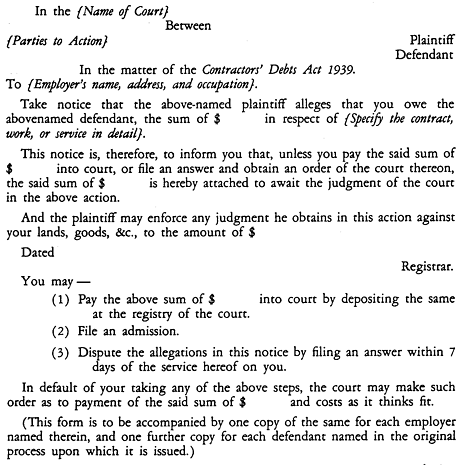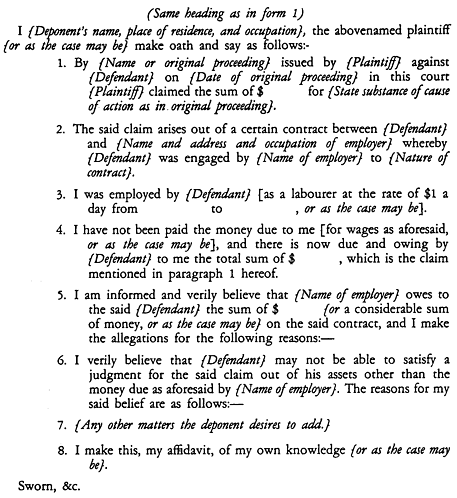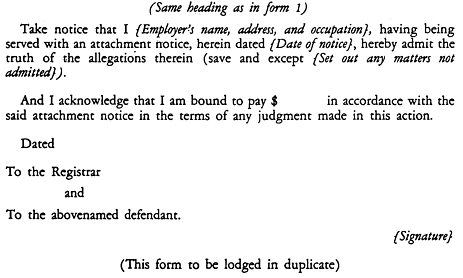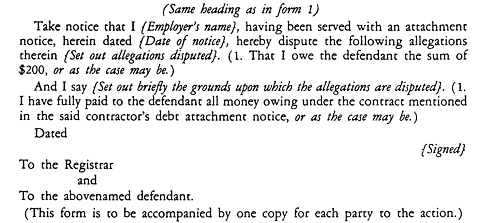Contractors' Debts Act 1939
An Act to provide for the better enforcement of payment of debts by contractors
Be it enacted by His Excellency the Governor of Tasmania, by and with the advice and consent of the Legislative Council and House of Assembly, in Parliament assembled, as follows:
This Act may be cited as the Contractors' Debts Act 1939 .
In this Act, unless the contrary intention appears –admission means a notice filed under this Act by an employer admitting his liability to a contractor;answer means a notice filed under this Act by an employer denying any allegation in an attachment notice;attachment notice means a contractor's debt attachment notice issued under this Act;contractor means any person not being an employee of the employer who has entered into any contract with an employer to do any work involving the employment of labour or the supply of materials by the contractor;court means any court in which an action for debt may be brought;employer means the person who has entered into a contract with a contractor to do any work or supply any materials;original proceeding includes any process in a court by which an action for debt may be commenced;served, in relation to any proceeding under this Act, means served in the same manner as an originating process in the court may be served.
In any action for debt, if the plaintiff, at any time after an original proceeding has been filed, files an affidavit showing that the claim is in respect of –the court may issue an attachment notice in Form 1 in Schedule 1 .(a) any –a specified contract made by the defendant with an employer;(i) wages for work performed by the plaintiff on or in relation to; or(ii) goods or materials supplied by the plaintiff to the defendant for use in and used, or intended to be used, by the defendant in or in respect of –(b) there is money owing or accruing due by the employer to the defendant in respect of such specified contract as aforesaid, and –(i) there is reasonable doubt that the plaintiff will be able to enforce a judgment for such claim except by attaching such money or portion thereof; or(ii) there are other sufficient reasons for the attachment of such money; and(c) the employer is within the jurisdiction of the court –
4. Proceedings for obtaining attachment notice
(1) Any plaintiff, in any action for debt in which an attachment notice may be issued under section 3 hereof, may lodge with the registrar of the court, at any time before final judgment is given, an attachment notice, together with an affidavit in Form 2 in Schedule 1 .(2) On receipt of the attachment notice and affidavit, the registrar shall –(a) issue the attachment notice; or(b) refer the application to the court, which shall hear the application and the parties affected thereby, and make such order thereon as to it seems just.
An attachment notice shall be signed by the registrar of the court, and shall be served on the employer.
(1) Service of an attachment notice upon the employer shall bind in the employer's hands all money then due or accruing due from the employer to the defendant in respect of the contract mentioned in the notice, to the extent of the sum mentioned in the original proceeding upon which the attachment notice is issued, or so much thereof as may be necessary to satisfy any judgment which may be made on the original process.(2) The service of the attachment notice shall not prevent the payment by the employer to the contractor of such amount as may be required in good faith by the contractor for the payment of the wages of workers employed by him in respect of the contract, and due at the time of the service of the notice or accruing due within 7 days thereafter.
(1) The court may order the discharge of an attachment notice at any time, and upon any terms, which to it appear just upon being satisfied that –(a) the employer does not owe any sum to the defendant;(b) that the defendant is able to satisfy otherwise any judgment which could be made in the action; or(c) the plaintiff has acted from any improper motive in issuing the attachment notice.(2) A contractor's debt attachment notice shall be deemed to be discharged –(a) if within 6 months after the date of issue, no judgment has been obtained in favour of the plaintiff on the original process on which it is issued;(b) forthwith on a judgment for the defendant in the action; or(c) if the action is withdrawn, abandoned, or struck out.
8. Procedure on part of employer
(1) Upon receipt of an attachment notice, an employer may –(a) pay into court the sum admitted by him as the amount then due by him to the contractor or such less sum as will be sufficient to satisfy any judgment in the action;(b) file in the court an admission in Form 3 in Schedule 1 ; or(c) file in the court an answer in Form 4 in Schedule 1 disputing the allegations in the attachment notice or any material part thereof.(2) Failure on the part of the employer to take any of the steps mentioned in subsection (1) will be regarded as equivalent to filing an admission, but the employer shall not be entitled to receive any costs or expenses.
9. Procedure on payment into court
(1) Where the employer pays money into court, the money so paid shall be appropriated by the final judgment in the action in such manner as the court considers just.(2) A payment into court shall be –(a) an acknowledgment by the employer that he has no further claim upon the money so paid; and(b) a full discharge, to the extent of the money so paid, of the liability of the employer to the contractor under the contract mentioned in the attachment notice upon which the money is paid into court.(3) An employer paying money into court shall be entitled to his proper costs and expenses occasioned by any proceedings under this Act, payment of which costs and expenses shall be provided for by the final judgment in the action.(4) In the event of more than one attachment notice being issued in respect of the same contract, any money paid into court by the employer will be apportioned by the final judgments in the several actions as the court considers just.(5) Upon being satisfied that other original proceedings have been filed in the same or any other court in actions arising out of the same contract, the court, at any time before final judgment, may direct that any money paid into court under this Act by an employer shall remain in court until final judgment is given in all the actions, and in such case the court shall apportion the money so paid into court amongst the several plaintiffs in the several actions as it thinks just.
10. Procedure on admission of amount owing
(1) In the event of the filing of an admission, any judgment against the contractor in respect of the claim specified in the attachment notice may, up to the amount so admitted, be enforced against the employer in the same manner as if the judgment had been against the employer as defendant.(2) In such case as is mentioned in subsection (1) , the employer shall be entitled to his proper costs and expenses up to the filing of the admission.(3) A copy of an admission shall be served on each plaintiff named in the original proceeding.(4) In proceedings under this Act –(a) in the event of an employer filing an admission for an amount less than the sum which the plaintiff in the action considers is due by the employer to the contractor, the plaintiff may call on the employer, by summons, to show cause why the admission should not be amended to cover the amount actually due as aforesaid;(b) upon the hearing of such summons as is mentioned in paragraph (a) , the court shall determine what sum is properly due by the employer to the defendant, and shall, if necessary, order the admission to be amended to cover the total sum so found to be due; and(c) the costs of and incidental to such summons as is mentioned in this subsection shall follow the event.
(1) An answer shall be filed within 7 days of the service on the employer of the attachment notice unless the court otherwise orders, and a copy thereof shall be served on or delivered to each plaintiff and defendant named in the original proceeding in the same manner as is prescribed by the rules of the court for serving or delivering a defence.(2) The plaintiff may set down for trial an issue upon the employer's answer at any time at or before the trial of the action or before signing judgment by default.(3) At least 3 days' notice of the trial of such issue shall be given to the employer and to the other parties to the action.(4) Upon the trial of the issue between the plaintiff in the action and the employer, the court shall hear the parties to the action and the employer, and shall finally determine the question of the liability of the employer to pay money to the contractor as stated in the attachment notice, and shall make such order as to it appears just, and the proceedings at the trial of such issue shall be in accordance with the rules of the court for the trial or hearing of the action.(5) Upon the application of the employer, if the court is satisfied by affidavit or otherwise that there are no reasonable grounds for the allegations contained in the attachment notice or any material part thereof, it may annul the attachment notice, with costs against the party at whose instance the same was issued.
12. Provisions where employer owes more than claim
In the event of an employer –the provisions of this Act shall be deemed to have been fully complied with, and the attachment notice shall not bind any further sum owing or accruing due by the employer to the contractor.(a) owing to the defendant a greater sum than could be recovered in a judgment upon the original proceeding upon which the attachment notice is issued; and(b) paying into court or filing an admission covering such sum as will be sufficient to meet any judgment as aforesaid –
Upon the presentation of a petition in bankruptcy against the contractor, all proceedings under the Act shall be suspended, but shall revive upon the refusal of a competent court to make a sequestration order or upon the bankruptcy proceedings being withdrawn or lapsing.
(1) The forms set out in Schedule 1 may be varied, repealed, or added to by rules.(2) Section 200 of the Supreme Court Civil Procedure Act 1932 shall apply to this Act, and rules may be made in accordance therewith to prescribe the procedure in any process under this Act.
(1) There shall be paid, on documents filed in the court, fees according to the scale prescribed for similar documents under rules relating to garnishee orders or, where no such fees are prescribed, for documents filed in an action for the amount stated in the attachment notice.(2) No fees shall be payable on filing an admission or an answer or upon paying money into court.(3) Costs of proceedings under this Act shall be in accordance with the scale prescribed for the relevant jurisdiction of the court in which the original proceeding is brought.(4) Unless the court otherwise orders, the proper costs and expenses of the employer shall be a first charge on any money recovered by the plaintiff in any proceeding under this Act.
SCHEDULE 1 - Forms
Form 1 - Attachment Notice
Form 2 - Affidavit in Support of Application for an Attachment Notice
Form 3 - Admission
Form 4 - Answer

 Loading..
Loading..



